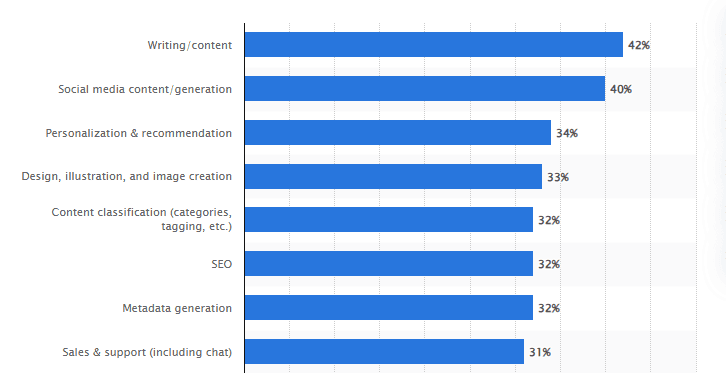Search engine optimization (SEO) has always been an ever-evolving industry, but the emergence of artificial intelligence (AI) is set to cause a seismic shift. As AI content detectors become more sophisticated, they will increasingly be able to identify content written by machines rather than humans.
This poses a significant challenge for content marketers who have come to rely on automation. However, with the right strategies, there are also opportunities to leverage AI to create higher quality, more engaging content.
In this article, we will explore how AI detectors work, the implications for content marketing, and actionable tips marketers can use to ensure their content passes AI screening. By understanding both the risks and possibilities, brands can prepare for the AI-powered future of SEO.

How Do AI Content Detectors Work?
AI content detectors use natural language processing (NLP) and machine learning algorithms to analyze writing styles and patterns. They identify signs a piece of content was computer-generated, such as:
- Repetitive phrasing and unnatural word patterns.
- Overuse of keywords and awkward transitions.
- Lack of coherence, logic gaps, and inconsistent facts/stats.
- Absence of creativity, humor, cultural references etc.
Detectors compare content against human-written samples to determine quality and originality. They assign a “human score” and can identify if writing style changes part way through an article, indicating some machine involvement.
As AI analyzes more content examples, the algorithms become increasingly advanced. Errors or quirks in earlier machine-written content teach an AI checker what to look for. This means it’s an ongoing battle for marketers as AI continually evolves.
The Implications for Content Marketing
Up to now, content marketing has benefitted from automation, enabling mass production at scale. However, as AI detectors improve their ability to identify machine-written content, this will become less effective. Content identified as low-quality risks is being demoted or removed from search rankings.
This will force brands to shift strategy and produce more content manually. The demand for skilled human writers will surge, yet marketers may struggle with the sudden drop in output and increase in costs.
Ultimately, though, improving content quality will lead to better outcomes. Human-written content drives more engagement, shares, and links—key SEO ranking factors. So, brands willing to invest in high-quality, original content have opportunities.
The Decline of Keyword Stuffing
In particular, AI detection spells the end of keyword stuffing. This common SEO tactic involves cramming content with target keywords to game search engines. However, detectors easily identify this unnatural style, meaning brands can no longer take shortcuts.
With keyword stuffing ineffective, writing informative, insightful content becomes critical. Each piece must add value for readers by offering something truly unique or useful.
Personalization and Creativity Become Vital
With the blanket content approach dead, personalization and creativity will be key differentiators. Brands able to infuse content with human personality, humor, cultural references, opinions, and emotions are more likely to pass AI detection.
This requires understanding target audiences on a deeper level to identify relevant themes, trends, and talking points. Tailoring content specifically for each demographic or buyer persona will also help make it feel more “human.”
Long-Form Content Has Greater Value
Long-form, in-depth content is also likely to fare better with AI detectors. Short pieces or thin content often rely more heavily on repetition to meet word counts. But rambling, detailed articles typical of human writers should pass AI checks more easily.
This makes long-form an attractive option for brands, particularly as it also tends to perform well with users. Lengthy, comprehensive guides can better demonstrate expertise while also answering more user questions in one place.
Multimedia Enhances Credibility
Articles that incorporate images, infographics, video, audio and other multimedia have a better chance of ranking with AI. Detectors can analyze these additional elements for further “human” signals not found in text alone.
Multimedia also increases engagement as users respond well to visual variety within content. For brands, curating related charts, memes, footage etc, boosts credibility by demonstrating extra effort.
Tips for Creating AI-Proof Content
The key tips for marketers to future-proof content against ever-advancing AI include:
- Prioritize manual writing over automation.
- Produce long-form, in-depth content.
- Inject personality, humor, opinions, and emotions.
- Tap into trends and current events.
- Add varied multimedia to reinforce messaging.
- Personalize content for target audiences.
- Use natural phrasing suited to the context.
- Ensure logical flow and structure.
- Back claims up with credible sources/stats.
Following these guidelines, brands can minimize reliance on repetition, keyword stuffing, and content spinners. Instead, the focus is placed on informative, engaging content tailored specifically for human readers.
The Role of AI Assistance Tools
Not all AI has to be avoided. Savvy brands can tap into AI tools to augment human-led content production.
AI article writing assistants, for example, help suggest related ideas, phrases, links, images and layouts. This aids writers rather than replaces them, resulting in more natural language.
Such tools increase efficiency for overworked marketing teams that have struggled to meet past volume expectations. Writers can also use AI to analyze their content, highlighting any repetitive or awkward sections that they can manually improve.
With strategic use, AI becomes an asset rather than a threat. The combination of human creativity and AI assistance results in top-notch content.
The Future of Personalized Content
In a 2024 global survey among marketing and media leaders, approximately 42% reported using artificial intelligence (AI) tools a few times per week or daily when writing or generating content. As AI content analysis continues to advance, even perfectly crafted human-written articles may eventually fail checks. Detectors will grow so smart that wholesale voice replication to game them will occur.

The future of content will be ultra-personalized, keeping brands one step ahead. Brands may develop “fingerprints” for individual writers on staff, consisting of syntax, diction, and linguistic quirks, or employ a diverse team of niche freelancers to maintain an array of unique voices.
Either way, the more personalized the writing style, the longer it will evade copycats. Duplication becomes exponentially harder with nuanced differences in narratives.
For consumers, it means content will resonate more as brands must understand exactly what makes each audience tick before publishing. So, while still a ways off, the gains from personalized content are well worth the added effort.
Conclusion
There’s no denying that AI is set to shake up the world of SEO and content marketing. As detectors step up analysis, brands must prioritize producing high-quality, original, human-written work.
Instead of being a catastrophic event, this transition creates a valuable opportunity. Brands implementing creative personalized content that hits directly with their defined user base will achieve superior business results. Higher audience involvement, along with more connections, will counteract any decrease in content quantity.
AI implementation under proper conditions enables marketers to use it as a support tool for managing repetitive tasks. The automation from AI allows content creators to add a genuine human touch, such as emotional content and humor, to their writing.

